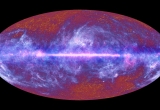Planck / HFI

Planck enables us to answer some of the most important questions of modern science: How did the Universe begin, how did it evolve into its current state, and how will it evolve in the future? The objective of Planck was to analyse, with unprecedented precision, the remnants of the radiation that filled the Universe right after the Big Bang, and that we observe today as the Cosmic Microwave Background.
Contact at IAS: Nabila Aghanim & Jean-Loup Puget
Name: Planck High-Frequency Instrument (HFI)
Definition : Planck is a satellite of the European Space Agency (ESA) that delivers all-sky maps in the submillimetric and radio domains (from 30 to 850 GHz), in temperature and polarisation.
Science objectives : Planck has been designed with the aim of measuring the anisotropies of the Cosmic Microwave Background on the whole sky with a sensitivity and an angular resolution never reached before. Planck data provide major information for several fields of cosmology and astrophysics, such as theories of the primordial Universe, the origin of large scale structures, and the physics of the Interstellar Medium.
Technical description : Planck is composed of two instruments : (1) the Low Frequency Instrument (LFI) - an array of radio-receivers using the HEMT amplification technology, that operates in the range of frequencies from 30 to 100 GHz; and (2) the High Frequency Instrument (HFI) - an array of bolometers, cooled down to 100 mK, that observes in the frequency range 100 to 850 GHz.
Planck did an all-sky survey every six months. Maps of the whole sky with a high angular resolution (FWHM~5'-30') and in all 9 frequency bands (30--850 GHz) have been released one year after the end of the mission. They provide the scientific community with a view of the entire sky of a quality never achieved before in this lesser-known frequency domain. This broad frequency coverage has been chosen for Planck so as to optimise the separation of components of galactic, extragalactic and cosmological origins.
Role of the IAS : The P.I. of Planck-HFI is Jean-Loup Puget, member of the IAS.
The IAS is strongly involved in serveral aspects of Planck-HFI, including instrumentation (tests and calibration at the IAS, thermal and mechanical design, integration, etc.), operations (within IDOC), data processing, analysis and interpretation (MIC team). Members of the IAS cotribute actively to many Planck Working Groups.
Status of the mission : Tests of Proto-Flight Model (PFM) of Planck-HFI have been done at the IAS in June-July 2006. Planck has been launched the 14 Mai 2009. Planck has succesfully accomplishd its mission. The last, switch-off command has been sent to the Planck telescope 23 October 2013 at at 12:10:27 UT. Members of the Planck consortium reduce, analyse and interpret Planck's data actively.



